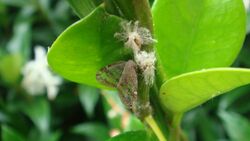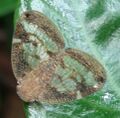Biology:Scolypopa australis
| Scolypopa australis | |
|---|---|

| |
| An adult and two nymphs | |
| Scientific classification | |
| Domain: | Eukaryota |
| Kingdom: | Animalia |
| Phylum: | Arthropoda |
| Class: | Insecta |
| Order: | Hemiptera |
| Suborder: | Auchenorrhyncha |
| Infraorder: | Fulgoromorpha |
| Family: | Ricaniidae |
| Genus: | Scolypopa |
| Species: | S. australis
|
| Binomial name | |
| Scolypopa australis (Walker, 1851)[1]
| |
Scolypopa australis, commonly known as the passionvine hopper, is a species of insect in the Ricaniidae family of planthoppers (Fulgoroidea) that is native to Australia and was introduced to New Zealand.[1][2] Despite its name, they are found not only on passion vines, but on many plant species, including kiwifruit and the lantana.[3][4] Brown with partly transparent wings, they are 5–6 mm long as adults and 5 mm as nymphs.[5] As an adult they look somewhat like a moth to the untrained eye, and walk "like a ballerina".[6] The nymphs are wingless and are informally known as fluffy bums.[6] When sufficiently aroused they will hop off their plant "with a 'snap'".[6] Like all planthoppers they suck plant sap. This leaves a honeydew secretion which bees gather.
In New Zealand
They were first recorded in New Zealand in 1878, where they are among over 40 species of planthopper, mostly native, but including the introduced Siphanta acuta (green planthoppers), Achilus flammeus (red fingernail bugs) and Anzora unicolor (grey planthoppers), all from Australia.[6] They may be a vector of the 'sudden decline' disease caused by Phytoplasma australiense that has affected the native cabbage tree (Cordyline australis), and are a common pest in gardens.[6] They are also found in regrowing forest.[2] They are very common in the summer and autumn north of Nelson.[6] Honey produced by honey bees that consume honeydew secreted on tutin containing tutu plants is known to cause honey poisoning.[7][8]
Gallery
Many on Kniphofia uvaria
Moving on New Zealand flax
References
- ↑ 1.0 1.1 "Species Scolypopa australis (Walker, 1851)". Australian Faunal Directory. https://biodiversity.org.au/afd/taxa/Scolypopa_australis. Retrieved 18 August 2018.
- ↑ 2.0 2.1 Hill, R.L.; Steven, D. (1989). "Scolypopa australis (walker), passionvine hopper (Homoptera: Ricaniidae)". in Cameron, P.J.; Hill, R.L.; Bain, J. et al.. A review of biological control of invertebrate pests & weeds in New Zealand 1874-1987. United Kingdom: CAB International. pp. 241–244. ISBN 0-85198-645-5.
- ↑ Johnson, Judith A. (1998). An introduction to Australian insects. UNSW Press. pp. 40. ISBN 0-86840-465-9. https://books.google.com/books?id=PA7kaflPjmoC&dq=Scolypopa+australis&pg=PA40. Retrieved 2009-04-23.
- ↑ Wise, K.A.J. (1995). "RECORDS CONCERNING BIOLOGICAL CONTROL OF INSECT PESTS BY NEUROPTEROIDEA (INSECTA) IN NEW ZEALAND". Records of the Auckland Institute and Museum 32: 101–117. ISSN 0067-0464.
- ↑ Martin, N.A. (2017). "Passion vine hopper - Scolypopa australis". Interesting Insects and other Invertebrates. Landcare Research. https://nzacfactsheets.landcareresearch.co.nz/factsheet/InterestingInsects/Passion-vine-hopper---Scolypopa-australis.html. Retrieved 18 August 2018.
- ↑ 6.0 6.1 6.2 6.3 6.4 6.5 Crowe, A. (2002). Which New Zealand Insect?. Auckland, N.Z.: Penguin. p. 87. ISBN 0-14-100636-6.
- ↑ Capinera, John L. (2008). Encyclopedia of Entomology. Springer. pp. 2928. ISBN 978-1-4020-6242-1. https://books.google.com/books?id=i9ITMiiohVQC&dq=Scolypopa+australis&pg=PA2928. Retrieved 2009-04-23.
- ↑ Beasley, M.; Hood, D.; Anderson, P.; Reeve, J.; Slaughter, R.J. (2018). "Poisoning due to tutin in honey: A report of an outbreak in New Zealand". New Zealand Medical Journal 131 (1473): 59–71. PMID 29649198.
Wikidata ☰ Q7434324 entry
 |






